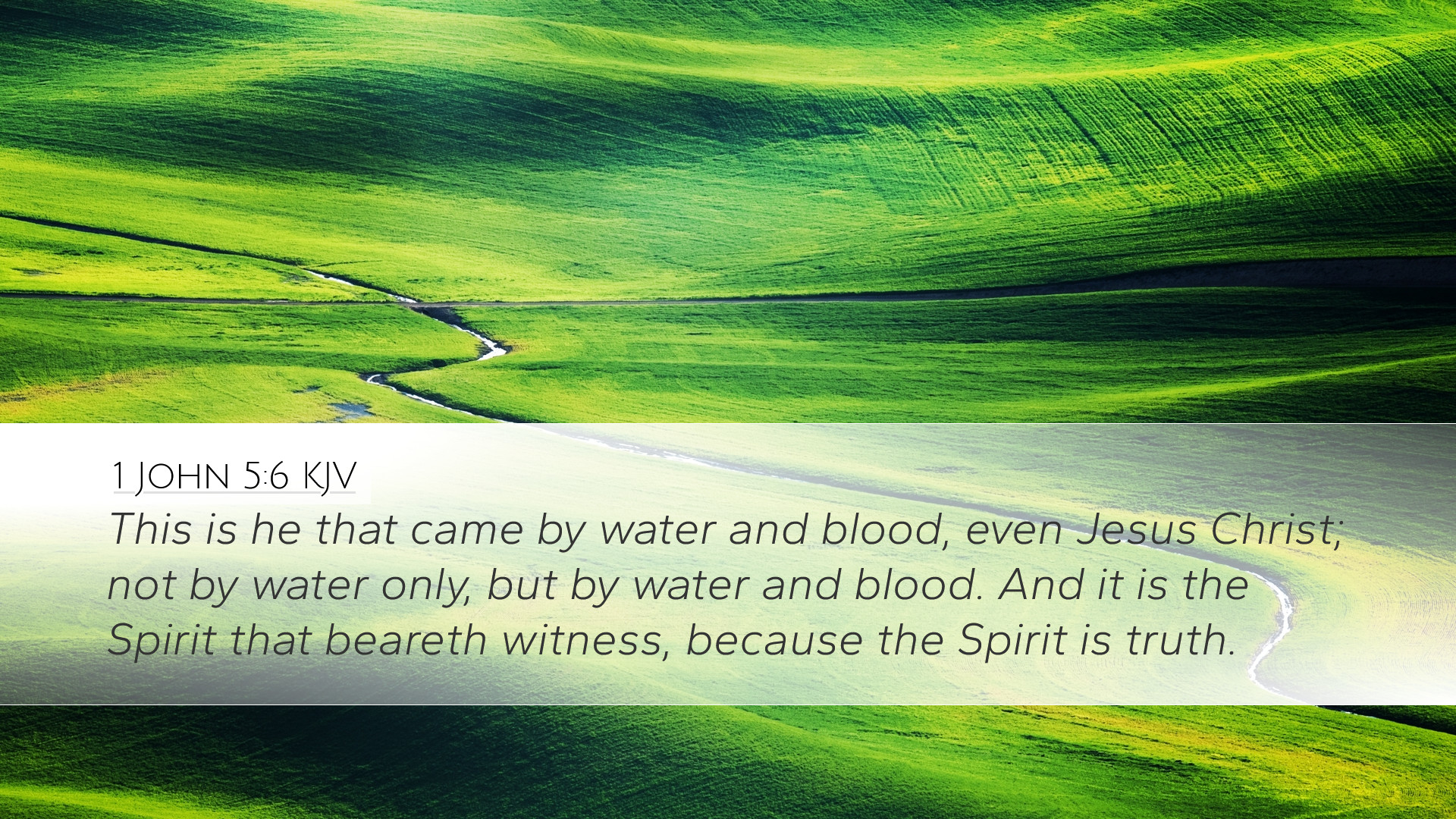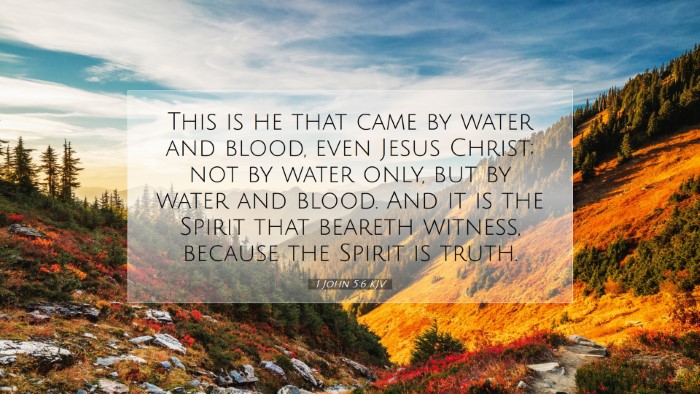Old Testament
Genesis Exodus Leviticus Numbers Deuteronomy Joshua Judges Ruth 1 Samuel 2 Samuel 1 Kings 2 Kings 1 Chronicles 2 Chronicles Ezra Nehemiah Esther Job Psalms Proverbs Ecclesiastes Song of Solomon Isaiah Jeremiah Lamentations Ezekiel Daniel Hosea Joel Amos Obadiah Jonah Micah Nahum Habakkuk Zephaniah Haggai Zechariah Malachi1 John 5:6
1 John 5:6 KJV
This is he that came by water and blood, even Jesus Christ; not by water only, but by water and blood. And it is the Spirit that beareth witness, because the Spirit is truth.
1 John 5:6 Bible Commentary
Commentary on 1 John 5:6
Verse: 1 John 5:6 (KJV) - "This is he that came by water and blood, even Jesus Christ; not by water only, but by water and blood. And it is the Spirit that beareth witness, because the Spirit is truth."
Introduction
This verse is pivotal in understanding the nature and significance of Jesus Christ’s dual witness to His life and ministry. The complexities of water and blood symbolize not only His sacrificial death but also His baptism and the fullness of His earthly ministry. We delve into various commentaries to extract profound meanings applicable to believers today.
The Identity of Christ
Matthew Henry's Commentary: Henry emphasizes the importance of recognizing Jesus as both divine and human. He notes that "coming by water and blood" refers to the full manifestation of Christ’s life, asserting that His baptism (water) and His crucifixion (blood) gave testimony to His identity as the Messiah.
Albert Barnes' Notes: Barnes remarks that the reference to water signifies the beginning of His ministry while blood signifies His atoning sacrifice. He highlights that it is crucial to understand Jesus' life and death as both essential for redemption, linking them as the foundation of Christian evidence and doctrine.
Adam Clarke's Commentary: Clarke adds depth by discussing the authenticity of Christ's humanity and divinity. He views this as a rejection of docetism, the idea that Christ only appeared to be human. The combination of "water and blood" serves as a testimony of Christ's genuine humanity coupled with His divine purpose.
The Symbolism of Water and Blood
Each element, water and blood, carries significant theological weight:
- Water: Represents purification and the initiation of Christ's ministry. It symbolizes His baptism where the Father acknowledges Him, setting Him apart for His mission.
- Blood: Symbolizes sacrifice and redemption. The blood shed at the crucifixion is the ultimate testament of love and the means of atonement for sins.
Henry suggests that these two elements should not be viewed in isolation but rather as components of a whole—each confirming the other and supporting the truth of the gospel narrative.
The Role of the Spirit
The scripture highlights the role of the Holy Spirit as the witness of truth. This aspect is profound for believers:
Albert Barnes' Insights: Barnes comments that the Spirit bears witness to the reality of Christ's work. The affirmation of truth by the Spirit assures believers of their faith in Christ’s nature and the authenticity of His atoning work.
Matthew Henry's Perspective: Henry explains that the Spirit empowers believers to understand and embrace this truth. The indwelling of the Holy Spirit allows the faithful to perceive and witness the reality of Christ in their lives.
Theological Implications
This verse presents crucial implications for theology, particularly in the areas of Christology and soteriology:
- Christology: Jesus is both fully God and fully man. His coming by water and blood underlines the necessity of His dual nature in fulfilling divine prophecy and making true atonement for humanity's sins.
- Soteriology: The salvation provided through Jesus is affirmed by both His life (water) and His death (blood). Understanding these aspects is critical when considering the fullness of the gospel message.
Practical Applications
Pastors, students, and theologians can draw several practical lessons from this verse:
- Affirming Faith: Believers are encouraged to affirm their faith through a deeper understanding of Christ's life and sacrificial death.
- Witnessing to Truth: The role of the Holy Spirit empowers believers to share the message of Christ’s redemptive work effectively.
- Living in Unity: The inseparable water and blood metaphor promotes the idea of living a life reconciled with God, grounded in both grace and truth.
Conclusion
1 John 5:6 is a multi-faceted verse that presents a rich tapestry of doctrine regarding Jesus Christ’s identity and mission. Insights from public domain commentaries deepen our understanding, emphasizing the critical elements of His incarnation, ministry, and sacrificial death. As believers embrace the truth of Christ's dual witness and the affirming power of the Holy Spirit, they are equipped to share this transformative message with the world.


